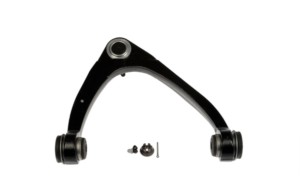The control arm is a fundamental component within your vehicle’s suspension system, yet it often goes unnoticed until problems arise. As an expert content creator for cars.edu.vn, I’m here to provide you with an in-depth understanding of control arms, their function, and what to look for when they start to fail. This guide will cover everything you need to know about control arms to keep your ride smooth and safe.
Understanding the Role of Control Arms
Imagine the suspension system of your car as the legs of a runner, constantly adapting to the terrain to ensure a stable and balanced movement. In this analogy, control arms are like the bones in the runner’s legs, providing structure and connection. Specifically, a control arm acts as a crucial link between your vehicle’s chassis or frame and the wheel hub assembly or steering knuckle. This connection is essential for managing wheel movement and maintaining vehicle stability.
Control arms are typically constructed from stamped or forged steel for strength and durability. They are designed to allow the wheels to move vertically in response to road irregularities while maintaining lateral control. Think of them as pivoting levers that manage the up-and-down motion of the suspension, ensuring your tires remain in contact with the road surface as much as possible. This constant contact is vital for optimal handling, braking, and overall vehicle control.
Most control arms feature a distinctive shape, often compared to an “A” or a wishbone. This design is functional, providing multiple points of attachment and distributing forces effectively. At the base of the “A” shape, where the two arms diverge, you’ll find control arm bushings. These bushings are typically made of rubber or polyurethane and act as pivot points, allowing the control arm to move smoothly and silently while absorbing road vibrations and shocks. At the tip of the “A”, the control arm connects to the steering knuckle via a ball joint.
Upper vs. Lower Control Arms
Vehicles are generally equipped with both upper and lower control arms, although some advanced suspension designs may differ.
- Lower Control Arms: These are typically larger and more robust as they bear the brunt of the suspension load and are crucial for maintaining vehicle ride height. They often connect to the lower part of the wheel hub assembly.
- Upper Control Arms: Usually lighter and sometimes shorter than their lower counterparts, upper control arms play a key role in controlling wheel camber (the angle of the wheel relative to the vertical axis) and suspension geometry.
While their specific designs and roles may vary depending on the vehicle’s suspension type (e.g., double-wishbone, MacPherson strut), both upper and lower control arms work in conjunction to ensure stable and controlled wheel movement.
Recognizing the Symptoms of a Failing Control Arm
Under normal driving conditions, control arms are built to last, often exceeding 100,000 miles and potentially lasting the lifetime of the vehicle itself. However, factors like poor road conditions, frequent exposure to potholes, heavy loads, and corrosion can accelerate wear and tear. Recognizing the signs of a failing control arm early can prevent more significant suspension and steering issues, and ensure your safety on the road.
Here are the common symptoms indicating you might have a bad control arm:
1. Clunking or Knocking Noises from the Suspension
One of the most tell-tale signs of a worn control arm, particularly the bushings or ball joint, is unusual noises emanating from the suspension system. This often manifests as a clunking, knocking, or rattling sound, especially when driving over bumps, potholes, or uneven road surfaces. You might also hear these noises when turning the steering wheel or applying the brakes.
These sounds are typically caused by worn or damaged control arm bushings. As the bushings degrade, they lose their ability to properly cushion and isolate the control arm, leading to metal-on-metal contact and the resulting noises. Similarly, a loose or worn ball joint can also produce clunking sounds as it moves excessively within its socket.
To diagnose this, you can visually inspect the control arm bushings for cracks, tears, or excessive wear. With the vehicle safely raised, try to manually wiggle the control arm to check for any excessive play, which could indicate bushing or ball joint issues.
2. Unstable or Wandering Steering
A faulty control arm can significantly impact your vehicle’s steering responsiveness. You might notice your car feeling unstable, wandering, or pulling to one side, even on a straight and level road. This instability can be particularly noticeable when steering or changing lanes, requiring constant corrections to keep the vehicle tracking straight.
This symptom often points to a bent or damaged control arm that is no longer holding the wheel assembly in the correct alignment. Worn bushings can also contribute to steering instability by allowing excessive movement in the suspension components.
A visual inspection of the control arm for any signs of bending or misalignment is crucial. If the arm appears distorted, it is likely contributing to the steering issues. A professional wheel alignment check can also confirm if the control arm is causing alignment problems.
3. Excessive Vibrations, Especially at Higher Speeds
When control arm bushings or the arm itself are compromised, you might experience unusual vibrations that are felt through the steering wheel, floor, or seats. These vibrations often become more pronounced at higher speeds.
Worn bushings lose their ability to dampen road vibrations effectively, allowing them to be transmitted directly into the vehicle’s cabin. A bent control arm can also lead to uneven tire wear, which in turn can cause additional vibrations and noise.
If you experience excessive vibrations, inspect your tires for signs of uneven wear patterns, such as bald spots or scalloping. Also, carefully examine the control arm bushings for cracks or deterioration.
4. Uneven and Premature Tire Wear
Abnormal or accelerated tire wear is another significant indicator of potential control arm problems. If you notice your tires wearing unevenly, particularly on the inside or outside edges (shoulder wear), or exhibiting feathering (a wave-like pattern across the tread), a damaged control arm or its bushings could be the culprit.
A malfunctioning control arm can disrupt your vehicle’s wheel alignment, leading to incorrect camber, caster, or toe angles. This misalignment causes uneven pressure distribution across the tire surface, resulting in irregular wear patterns and reduced tire lifespan.
If you observe unusual tire wear, it’s highly recommended to have your vehicle’s wheel alignment checked by a qualified technician. If alignment issues are present and other suspension components like tie rod ends and ball joints are in good condition, the control arm is a prime suspect.
5. Poor Handling and Reduced Suspension Performance
A compromised control arm can negatively impact your vehicle’s overall handling and suspension performance. You might notice the suspension feeling less responsive, overly bouncy, or struggling to maintain proper tire contact with the road, especially when cornering or encountering uneven surfaces. The vehicle may feel less stable and less predictable in turns.
To assess your suspension performance, you can perform a simple bounce test. Push down firmly on the front corner of your vehicle (e.g., over a fender) and release it quickly. Observe how the vehicle rebounds. Excessive bouncing (more than 2-3 oscillations) can indicate suspension issues, which could be related to the control arms or other suspension components.
Addressing Control Arm Issues
If you suspect a problem with your control arms based on these symptoms, it’s crucial to address them promptly. Neglecting a failing control arm can lead to more severe suspension damage, steering system failure, and compromised vehicle safety.
Control arm replacement costs can vary significantly depending on the vehicle make and model, and whether you opt for professional repair or DIY. Generally, expect to pay between $200 to $800 for parts and labor at a repair shop. DIY replacement can reduce costs to $50 to $400 for the control arm part itself. Remember that a wheel alignment is always necessary after control arm replacement to ensure proper suspension geometry and prevent tire wear.
DIY control arm replacement can range from 1 to 3 hours per side, depending on your mechanical skill level, tool availability, and vehicle complexity. While some experienced DIYers can handle this task, consulting a certified mechanic is advisable if you are unsure or lack the necessary tools and experience.
For high-quality replacement control arms and related suspension components, consider reputable auto parts retailers like AutoZone. They offer parts from trusted brands like Duralast, ensuring quality and compatibility for a wide range of vehicle makes and models. Their knowledgeable staff can also provide advice and guidance on parts selection and repair procedures.
FAQ About Control Arms
How do you know if a control arm is bad?
Listen for clunking noises, observe for steering instability, feel for excessive vibrations, and check for uneven tire wear. These are common indicators of a failing control arm.
What happens if your control arm breaks while driving?
A broken control arm is a serious safety hazard. It can cause suspension collapse, wheel separation, and a sudden loss of vehicle control, potentially leading to accidents.
What do bad control arms sound like?
Bad control arms typically produce clunking, knocking, or rattling noises, especially when driving over bumps, turning, or braking.
How do I know if my car needs new control arms?
If you experience symptoms like poor handling, uneven tire wear, or unusual noises from the suspension, it’s time to inspect your control arms for wear or damage.
How do you test a control arm on a car?
Safely raise the vehicle and visually inspect the control arm and its bushings for damage. Attempt to wiggle the control arm to check for excessive play, which indicates wear in the bushings or ball joint.
What is the life expectancy of control arms?
Control arms typically last for 100,000 miles or more under normal driving conditions. However, lifespan can be reduced by rough roads, heavy loads, and lack of maintenance. Regular inspections can help identify issues early and extend their service life.

